For eight nights in November or December every year, the Jewish holiday Hanukkah is observed across the world – bringing friends and family together through tradition to commemorate part of Judaism’s deep history.
Hanukkah, also called Chanukah, is also known as the “Festival of Lights” and means “dedication” in Hebrew.
Here’s what you need to know about the holiday’s history and why it's celebrated through the lighting of menorahs, symbolic foods and games.
When is Hanukkah this year?
Get top local stories in Southern California delivered to you every morning. >Sign up for NBC LA's News Headlines newsletter.
This year, the holiday will be observed between sundown Dec. 7 and sundown Dec. 15. The dates of the multi-day holiday varies by year and is decided by the Hebrew month of Kislev. According to Chabad.org, Kislev is the ninth month on the Jewish calendar and marks the onset of the winter season in the Holy Land.
Hanukkah begins on the 25th day of Kislev.
How is Hanukkah observed across the world?
Holidays
From gift guides to local events, we're here to help you celebrate in style.
Jews across the world, no matter the branch of Judaism they observe, center their celebration of the holiday on the same practice: lighting a menorah. A menorah means “lamp” in Hebrew and has several branches, according to Chabad.org. The menorah used for Hanukkah has eight branches and symbolizes divine light. It is often placed in a doorway or window of a home to emit the light of the flames to neighbors.
On the first night of Hanukkah, which falls on Dec. 7 this year, two candles on the menorah are lit, the shamash and the first branch. The shamash candle is used to light all of the proceeding candles. Shamash means “helper” in Hebrew.
Another candle is added from the right to the left every night after sunset, excluding Fridays, when the menorah is lit before the Shabbat candles. Every night when the candles are lit, it is done from left to right on the menorah.
Lighting the menorah in this order pays homage to how the first five books of the Hebrew Bible, the Torah, is read: from right to left.
As the shamash candle is used to light the branches each night, designated blessings honoring God are recited.
How else is Hanukkah celebrated?
Although the lighting of the menorah is the main way Hanukkah is celebrated, other traditions are predominant and represent their own history in the larger story of Judaism, one steeped in history.
Menorahs are not only lit inside of homes, they are often lit and displayed in public spheres. Last year, President Joe Biden gave the White House its own menorah for the first time.
Although not historically part of the Hanukkah celebration, many Jewish parents in the U.S. give their children presents in celebration of the important holiday. Oftentimes, every child receives a present for each night of Hanukkah.
Dreidel games are also played as a way to celebrate, specifically by children. A dreidel is a spinning top with four sides marked with Hebrew letters. Winners of varying dreidel games often receive money or sweet treats. The games were historically used as a way to study the Torah while all Jewish practices were outlawed during the reign of Greek Hellenistic king Antiochus IV.
Like many holidays, food is central to Hanukkah’s celebration. The foods at the heart of the holiday are sufganiyot and latkes. The Israeli treat sufganiyot is often described as a cross between a beignet and a jelly donut. Latkes are potato pancakes often eaten with applesauce or sour cream.
Both treats are fried in oil as a way to commemorate the “miracle of the oil” that happened during the Maccabean revolt when a small amount of oil burned for eight days straight after it was used to light the Holy Temple’s menorah, according to the North American Olive Oil Association.
What is the importance and history of Hanukkah?
Hanukkah is not considered the most important holiday to the Jewish faith. In the fall, Jews celebrate the High Holy Days of Rosh Hashanah and Yom Kippur, which are considered two of the most sacred holidays. Rosh Hashanah is the Jewish New Year and Yom Kippur is the Day of Atonement.
Hanukkah's origins are rooted in the rededication of the temple in Jerusalem during the rule of Antiochus IV of the Seleucid Empire. After seizing Judea in 167 B.C.E., Antiochus IV was devoted to restricting Judaism and bolstering Greek tradition and religion.
In the fall of 164 B.C.E., Jews recaptured the temple in Jerusalem after Antiochus had dedicated it to the Olympian god Zeus, according to National Geographic.
When the temple was recaptured, the Seleucids left only one vial of oil, which was considered to be enough to light the Temple’s candelabrum for one day, but it burned for eight days.
Hanukkah is celebrated for eight days to thank God for Jewish deliberation and victory of light over darkness.



